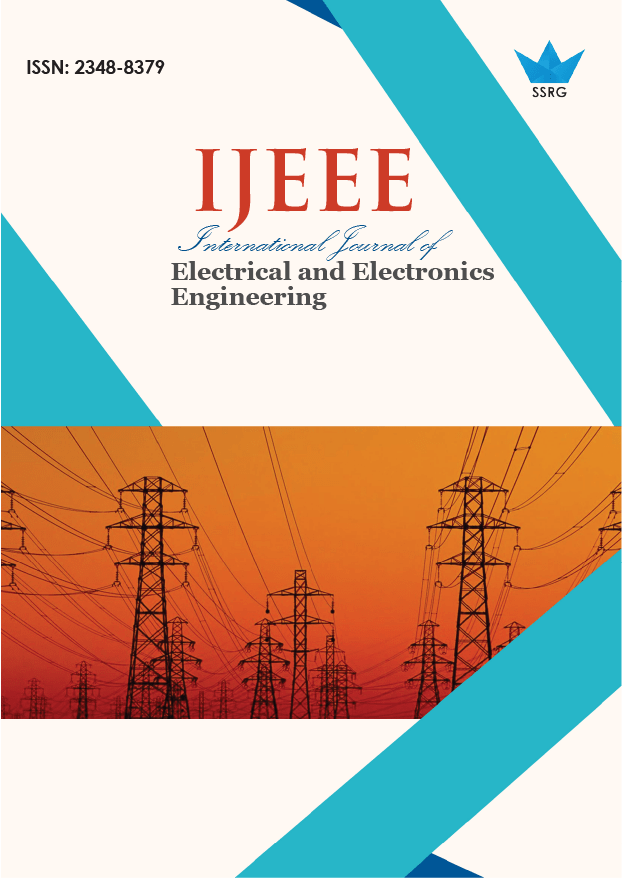A Double-Slotted Microstrip Rectangular 6x6 Array for Sub-6 GHz Wireless Applications

| International Journal of Electrical and Electronics Engineering |
| © 2024 by SSRG - IJEEE Journal |
| Volume 11 Issue 2 |
| Year of Publication : 2024 |
| Authors : Fahmida Hossain, Mohd Khanapiah Bin Nor, A.K.M. Zakir Hossain, Nurulhalim Bin Hassim |
How to Cite?
Fahmida Hossain, Mohd Khanapiah Bin Nor, A.K.M. Zakir Hossain, Nurulhalim Bin Hassim, "A Double-Slotted Microstrip Rectangular 6x6 Array for Sub-6 GHz Wireless Applications," SSRG International Journal of Electrical and Electronics Engineering, vol. 11, no. 2, pp. 107-118, 2024. Crossref, https://doi.org/10.14445/23488379/IJEEE-V11I2P112
Abstract:
In this article, a double-slotted microstrip rectangular 6×6 MIMO array antenna is proposed with an intention for the sub-6 GHz smartphone and wireless applications. In this proposed design, the Partial Ground Plane (PGP) technique is applied to the Single-Element Antenna (SEA) design to achieve an Ultra-Wideband (UWB) response of 1.43GHz. The design works within 3.1 to 4.53 GHz of -10 dB S-parameter bandwidth (BW). The SEA has a small dimensions of only 40 × 30 mm² and a 0.508 mm thickness. Moreover, the 6-element array aligns with 6.6-inch display smartphones by having a final dimension of 75 × 150 mm². The MIMO performance parameters of this proposed design have a good isolation of below -16.6 dB between the ports. Furthermore, the maximum Realized Gain (RG) of 5.44 dBi, and a Total antenna Efficiency (TE) of as high as 80% are achieved by simulation and also validated through measurement. Likewise, the Envelope Correlation Coefficient (ECC) of this MIMO array stays consistently below 0.004 and has a Diversity Gain (DG) of more than 9.98 throughout the entire BW. Additionally, the Specific Absorption Rate (SAR) analysis with Hand-Head phantom reveals a remarkable result of as low as 0.094 W/kg for 10g mass at port 2, whereby the value never goes higher than 0.413 W/kg at any port that ensures compliance with MIMO standards for smartphone applications.
Keywords:
ECC, MIMO, PGP, RG, Wireless.
References:
[1] Arun Pant, Manish Singh, and Manoj Singh Parihar, “A Frequency Reconfigurable/Switchable MIMO Antenna for LTE and Early 5G Applications,” AEU - International Journal of Electronics and Communications, vol. 131, 2021.
[CrossRef] [Google Scholar] [Publisher Link]
[2] Jingli Guo et al., “Side-Edge Frame Printed Eight-Port Dual-Band Antenna Array for 5G Smartphone Applications,” IEEE Transactions on Antennas and Propagation, vol. 66, no. 12, pp. 7412-7417, 2018.
[CrossRef] [Google Scholar] [Publisher Link]
[3] Naveen Kumar, and Rajesh Khanna, “A Two Element MIMO Antenna for Sub-6 GHz and mmWave 5G Systems Using Characteristics Mode Analysis,” Microwave and Optical Technology Letters, vol. 63, no. 2, pp. 587-595, 2021.
[CrossRef] [Google Scholar] [Publisher Link]
[4] Amany A. Megahed et al., “5G Millimeter Wave Wideband MIMO Antenna Arrays with High Isolation,” EURASIP Journal on Wireless Communications and Networking, vol. 2023, pp. 1-16, 2023.
[CrossRef] [Google Scholar] [Publisher Link]
[5] A.K.M. Zakir Hossain et al., “A Planar 2×2 MIMO Antenna Array for 5G Smartphones,” International Journal of Advanced Computer Science and Applications, vol. 12, no. 7, pp. 710-717, 2021.
[CrossRef] [Google Scholar] [Publisher Link]
[6] Zhouyou Ren, and Anping Zhao, “Dual-Band MIMO Antenna with Compact Self-Decoupled Antenna Pairs for 5G Mobile Applications,” IEEE Access, vol. 7, pp. 82288-82296, 2019.
[CrossRef] [Google Scholar] [Publisher Link]
[7] Jianlin Huang et al., “A Quad-Port Dual-Band MIMO Antenna Array for 5G Smartphone Applications,” Electronics, vol. 10, no.5, pp. 1- 9, 2021.
[CrossRef] [Google Scholar] [Publisher Link]
[8] Muhammad Ali Jamshed et al., “Dual Band and Dual Diversity Four-Element MIMO Dipole for 5G Handsets,” Sensors, vol. 21, no. 3, pp. 1-13, 2021.
[CrossRef] [Google Scholar] [Publisher Link]
[9] Vandana Yadav et al., “Dual and Wideband 6-Port MIMO Antenna for WiFi, LTE and Carrier Aggregation Systems Applications,” AEU - International Journal of Electronics and Communications, vol. 162, 2023.
[CrossRef] [Google Scholar] [Publisher Link]
[10] Mohamed M. Morsy, “Compact Eight-Element MIMO Antenna Array for Sub 6 GHz Mobile Applications,” SN Applied Sciences, vol. 5, pp. 1-7, 2023.
[CrossRef] [Google Scholar] [Publisher Link]
[11] Naser Ojaroudi Parchin et al., “An Efficient Antenna System with Improved Radiation for Multi-Standard/Multi-Mode 5G Cellular Communications,” Scientific Reports, vol. 13, pp. 1-7, 2023.
[CrossRef] [Google Scholar] [Publisher Link]
[12] Haroon Ahmed et al., “Sub-6 GHz MIMO Antenna Design for 5G Smartphones: A Deep Learning Approach,” AEU - International Journal of Electronics and Communications, vol. 168, 2023.
[CrossRef] [Google Scholar] [Publisher Link]
[13] Zhonggen Wang et al., “Design of MIMO Antenna with Double L-Shaped Structure for 5G NR,” Symmetry, vol. 15, pp. 1-13, 2023.
[CrossRef] [Google Scholar] [Publisher Link]
[14] Muhammad Zahid et al., “Ten-Port MIMO Inverted-F Antenna for LTE Bands 43/48/49 Bands Smartphone Applications,” Electronics, vol. 12, no. 19, pp. 1-14, 2023.
[CrossRef] [Google Scholar] [Publisher Link]
[15] Ji-Peng Jhuang, and Hsin-Lung Su, “A Compact 12 × 12 MIMO Loop Antenna for 5G Mobile Phone Applications,” International Journal of Microwave and Wireless Technologies, pp. 1-11, 2023.
[CrossRef] [Google Scholar] [Publisher Link]
[16] Chih Chung Lin et al., “Compact Sub 6 GHz Dual Band Twelve-Element MIMO Antenna for 5G Metal-Rimmed Smartphone Applications,” Micromachines, vol. 14, pp. 1-17, 2023.
[CrossRef] [Google Scholar] [Publisher Link]

 10.14445/23488379/IJEEE-V11I2P112
10.14445/23488379/IJEEE-V11I2P112